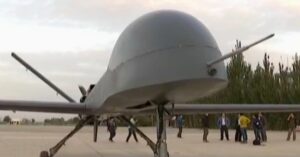 WASHINGTON: China’s newest drone, the Caihong 5, appeared in last night’s huge military parade in Beijing. Chinese media are comparing the Medium Altitude Long Endurance (MALE) drone to America’s MQ-9 Reaper, which with up to four Hellfire missiles and two 500-lb. precision-guided bombs under its wings is the baddest drone known.
WASHINGTON: China’s newest drone, the Caihong 5, appeared in last night’s huge military parade in Beijing. Chinese media are comparing the Medium Altitude Long Endurance (MALE) drone to America’s MQ-9 Reaper, which with up to four Hellfire missiles and two 500-lb. precision-guided bombs under its wings is the baddest drone known.
(Today’s parade is ostensibly put on to celebrate the 70th anniversary of “victory in the Chinese People’s War Against Japanese Aggression” — better known to English speakers as the end of World War II. The fact is, China did relatively little to defeat Japan, since Chiang Kai-shek saved much of the cash and weapons we supplied him during the war to try and defeat Mao Zedong’s Communist army once the other allies defeated Japan. The Editor)
To the untrained eye the two drones may look a hell of a lot alike. But we hear from experts who cannot be named that the similarities between the Caihong 5 and the Reaper are at best superficial. Our experts work on black drone programs and can’t speak on the record.
The Caihong 5 has both a radome nose and an upward pointing V-tail like the Reaper, and its 66 foot wingspan is exactly the same as the American drone. According to Chinese media, the Caihong 5’s maximum gross takeoff weight is about 6,000 lbs., well below the Reaper’s 10,500 lbs., and Beijing’s Reaper knockoff has a reported maximum payload of 900 kilograms (1,984 lbs.), far less than the MQ-9’s combined payload of 3,000 lbs. external and 850 lbs. internal. The Reaper’s combined payload is about 1,749 kilos, nearly double the Caihong 5’s.
But that tale of the tape is just as superficial as the Caihong 5’s resemblance to the Reaper.
“There is no magic to building these vehicles,” said one expert who played a key role in developing the smaller Predator (Reaper’s father), the General Atomics Aeronautical Systems Inc. drone whose unprecedented endurance of more than 24 hours airborne broke the mold in unmanned systems. “The magic is in getting them to do what you want them to do when and where you want them to do it.”
The Caihong 5’s manufacturer, China Aerospace Science and Technology Corporation, told Chinese media their drone can carry six missiles and stay airborne 30 hours, which is significantly more than the Reaper’s usual endurance of 18 to 27 hours, depending on what it carries. Chief designer Ou Zhongming said the Caihong 5 also has a “powerful wall-penetrating radar (that) would change the way that military drones are used in counterterrorism missions.”
Maybe, but don’t believe it til you see it. “There is stuff like that out there, but it’s not very mature,” one expert said. In any event, this person added, “They don’t have any kind of similar sensor or weapons capability” to the Reaper.
Duplicating external hardware is one thing; duplicating the internal software that allows Predator and Reaper operators to track and attack targets on the other side of the globe would be a (don’t miss this reference) great leap forward for the Chinese indeed. It isn’t as simple as signing up for satellite TV. Even many drone “experts” don’t realize that the U.S. system of Remote Split Operations, as it’s called, relies on fiber optic cable to carry control and data signals to and from the United States to satellite earth links in Europe and then on to Predators and Reapers. That’s the only way the delay in the signal can be held to the necessary maximum of 1.3 seconds or less.
 How much thought the Chinese may have devoted to capabilities like that is unclear, of course, but judging by the Caihong 5’s outward appearance, “It’s obvious they didn’t think real hard on being original,” one Reaper expert said.
How much thought the Chinese may have devoted to capabilities like that is unclear, of course, but judging by the Caihong 5’s outward appearance, “It’s obvious they didn’t think real hard on being original,” one Reaper expert said.
How the “Rainbow” got its name is unclear, but the Reaper got its name more or less by happenstance, as I learned at a 2010 ceremony dedicating installation of the second MQ-9 in the Air Force Museum in Dayton, Ohio.
In 2006, as Air Combat Command was trying to come up with a name for what until then had been the “Predator B,” Lt. Col. Jonathan Greene, first commander of the first squadron to use the MQ-9, was asked to weigh in.
“They couldn’t come up with a name that they liked,” Greene told me in 2010. “So they were asking me down at the squadron level what I thought. I provided a few names, like Demon. I was trying to think along the ‘Predator’ line, in the same vein as ‘Predator.’” Then Greene spent a weekend with his father in New Mexico and asked him for ideas. “I said, ‘Hey, we’re trying to come up with the name for this aircraft. Everybody’s racking their brains.’ He said, ‘Well, what about Reaper, like Grim Reaper?’ I said, ‘Yeah, that sounds great.”” Greene said he submitted the name to Air Combat Command the following Monday.
The chief of staff at the time, Gen. T. Michael “Buzz” Moseley, loved it.
“ACC brought it to me and I immediately approved it,” Moseley recalled. The name Reaper “has got the panache. It’s got kind of a classic combat aircraft name to it. And it does kind of paint a picture of what we’ve been tasked to do.”
In a ‘world first,’ DARPA project demonstrates AI dogfighting in real jet
“The potential for machine learning in aviation, whether military or civil, is enormous,” said Air Force Col. James Valpiani. “And these fundamental questions of how do we do it, how do we do it safely, how do we train them, are the questions that we are trying to get after.”



























